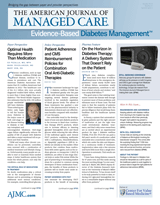- Center on Health Equity & Access
- Clinical
- Health Care Cost
- Health Care Delivery
- Insurance
- Policy
- Technology
- Value-Based Care
Race and Gender, Additional Risk Factors in Diabetes for Night-Shift Workers, Study Finds
A huge prospective cohort study, currently ongoing in academic centers in Massachusetts, has identified that African American women who had extended periods of nightshift work had an increased incidence of type 2 diabetes mellitus (T2DM).1 The Black Women’s Health Study (BWHS) followed 28,041 women from 2005-2013, based on a questionnaire that identified
them to have worked the night shift. Previous research has shown that shift work reduces employee wellbeing; working nights—or worse, rotating shifts—increases the risk of obesity, insomnia, hypertension, stomach ulcers, depression, workplace injury, tobacco use, heart disease, and diabetes.2
Another recent meta-study, published in Occupational & Environmental Medicine, found that any amount of time spent doing shift work increases the risk of diabetes huge prospective cohort study, currently ongoing in academic centers in Massachusetts, has identified that African American women who had extended periods of nightshift work had an increased incidence of type 2 diabetes mellitus (T2DM).1
The Black Women’s Health Study (BWHS) followed 28,041 women from 2005-2013, based on a questionnaire that identified them to have worked the night shift.
Previous research has shown that shift work reduces employee wellbeing; working nights—or worse, rotating shifts—increases the risk of obesity, insomnia, hypertension, stomach ulcers, depression, workplace injury, tobacco use, heart disease, and diabetes.2 Another recent meta-study, published in Occupational & Environmental Medicine, found that any amount of time spent doing shift work increases the risk of diabetes by 9%.3 Interestingly, the results, the product of a meta-analysis of 12 international studies, found a more significant correlation between shift work and diabetes in men than in women.
The BWHS study found that during the 8 years of follow-up, 1786 women developed diabetes. Relative to women who had never worked the night shift, hazard ratios (HRs) (95% CI) for diabetes were 1.17 (1.04, 1.31) for 1 to 2 years of night-shift work, 1.23 (1.06, 1.41) for 3 to 9 years, and 1.42 (1.19, 1.70) for ≥10 years (P < .0001). The study results found a 23% increased incidence of T2DM among women who had the longest duration of working the night shift. Further, while obesity did not seem to influence disease prevalence, women older than 50 years working the night shift had a lower incidence of diabetes. The authors conclude that their study has broad societal implications, considering that a high percentage of employees in the United States work the night shift, and they suggest that circadian adaptation for shift-work employees needs more attention and research.
References
1. Vimalananda VG, Palmer JR, Gerlovin H, et al. Night-shift work and incident diabetes among African-American women [published online: January 11, 2015] Diabetologia. doi:10.1007/s00125-014-3480-9.
2. Smith, A. New research shows employers need strategies to help night shift workers avoid diabetes. Am J Manag Care. 2014;20(SP18): SP579-SP580.
3. Gan Y, Yang C1, Tong X, et al. Shift work and diabetes mellitus: a meta-analysis of observational studies [published online July 16, 2014]. Occup Environ Med. 2015;72(1):72-78.

Exploring Pharmaceutical Innovations, Trust, and Access With CVS Health's CMO
July 11th 2024On this episode of Managed Care Cast, we're talking with the chief medical officer of CVS Health about recent pharmaceutical innovations, patient-provider relationships, and strategies to reduce drug costs.
Listen
Integrated Care for Chronic Conditions: A Randomized Care Management Trial
December 3rd 2025The authors sought to understand the differential impact of payer-led community-based care management approaches on stakeholder-oriented outcomes for publicly insured adults with multiple chronic conditions.
Read More

